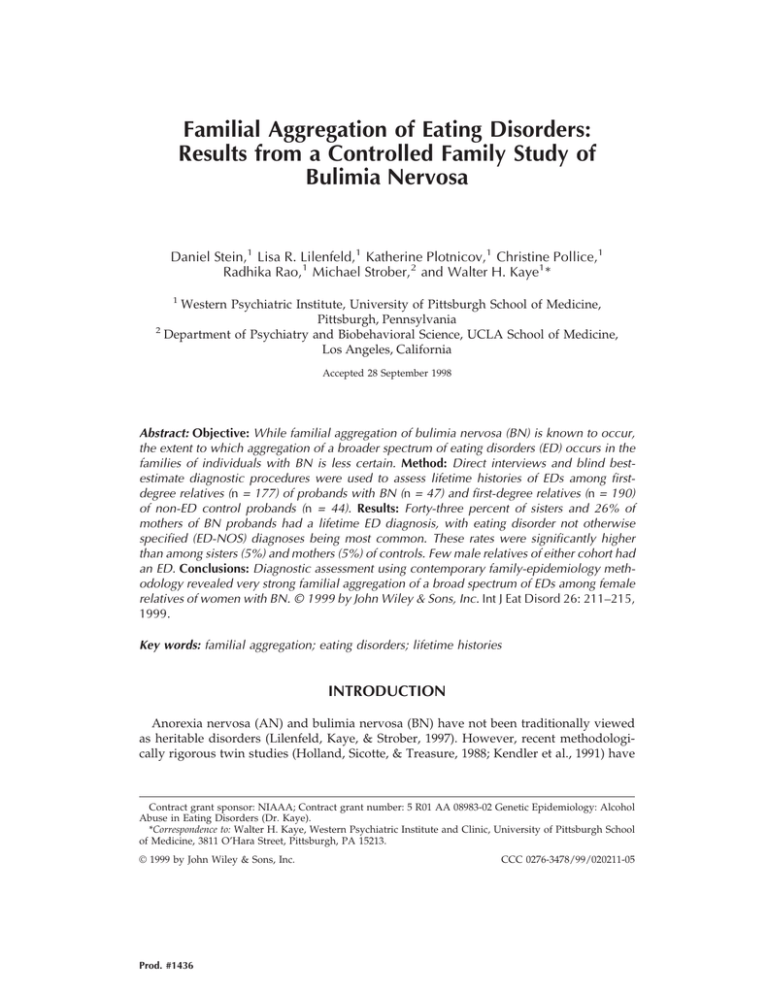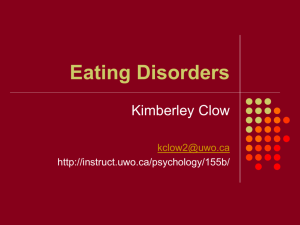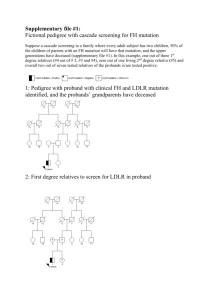Familial Aggregation of Eating Disorders: Bulimia Nervosa
advertisement

Familial Aggregation of Eating Disorders: Results from a Controlled Family Study of Bulimia Nervosa Daniel Stein,1 Lisa R. Lilenfeld,1 Katherine Plotnicov,1 Christine Pollice,1 Radhika Rao,1 Michael Strober,2 and Walter H. Kaye1* 1 Western Psychiatric Institute, University of Pittsburgh School of Medicine, Pittsburgh, Pennsylvania 2 Department of Psychiatry and Biobehavioral Science, UCLA School of Medicine, Los Angeles, California Accepted 28 September 1998 Abstract: Objective: While familial aggregation of bulimia nervosa (BN) is known to occur, the extent to which aggregation of a broader spectrum of eating disorders (ED) occurs in the families of individuals with BN is less certain. Method: Direct interviews and blind bestestimate diagnostic procedures were used to assess lifetime histories of EDs among firstdegree relatives (n = 177) of probands with BN (n = 47) and first-degree relatives (n = 190) of non-ED control probands (n = 44). Results: Forty-three percent of sisters and 26% of mothers of BN probands had a lifetime ED diagnosis, with eating disorder not otherwise specified (ED-NOS) diagnoses being most common. These rates were significantly higher than among sisters (5%) and mothers (5%) of controls. Few male relatives of either cohort had an ED. Conclusions: Diagnostic assessment using contemporary family-epidemiology methodology revealed very strong familial aggregation of a broad spectrum of EDs among female relatives of women with BN. © 1999 by John Wiley & Sons, Inc. Int J Eat Disord 26: 211–215, 1999. Key words: familial aggregation; eating disorders; lifetime histories INTRODUCTION Anorexia nervosa (AN) and bulimia nervosa (BN) have not been traditionally viewed as heritable disorders (Lilenfeld, Kaye, & Strober, 1997). However, recent methodologically rigorous twin studies (Holland, Sicotte, & Treasure, 1988; Kendler et al., 1991) have Contract grant sponsor: NIAAA; Contract grant number: 5 R01 AA 08983-02 Genetic Epidemiology: Alcohol Abuse in Eating Disorders (Dr. Kaye). *Correspondence to: Walter H. Kaye, Western Psychiatric Institute and Clinic, University of Pittsburgh School of Medicine, 3811 O’Hara Street, Pittsburgh, PA 15213. © 1999 by John Wiley & Sons, Inc. Prod. #1436 CCC 0276-3478/99/020211-05 212 Stein et al. found increased concordance rates of AN, BN, or both, among monozygotic twins in whom the affected twin had either one of these disorders, compared to dizygotic twins. The heritability estimates for both AN and BN in most studies ranged from 0.54 to 0.80, supporting the putative role of genetically transmitted liability factors in both disorders and suggesting that some of these factors may be shared between them (Lilenfeld et al., 1997). Furthermore, Bulik, Sullivan, and Kendler (1999) have recently found particularly high heritabilities for both latent binge eating (82%) and broadly defined BN (83%). Family studies do not distinguish between genetic and environmental transmission (Strober, Lampert, Morrell, Burroughs, & Jacobs, 1990). Nevertheless, the finding of limited influence of shared environmental factors in the variance of disordered eating among family members, the finding that genotypic influences may determine, at least in part, the nature of experiences to which the individual is attracted, and the infrequency of severe forms of eating disorders (EDs) in the face of robust cultural influences concerning weight and shape support the putative role of genetic processes in the familial transmission of EDs (Bulik et al., 1999; Lilenfeld et al., 1997; Strober et al., 1990). A review of published controlled family studies suggests that some (Gershon et al., 1983; Kassett et al., 1989; Strober et al., 1990), although not all (Halmi et al., 1991; Hudson, Pope, Jonas, YurgelunTodd, & Frankenburg, 1987; Logue, Crowe, & Bean, 1989; Stern et al., 1992), have found that the relatives of probands with either AN or BN demonstrate elevated rates (three to fivefold) of both disorders compared to the relatives of non-ED controls. Interestingly, all studies demonstrating an increased risk of EDs among relatives were conducted with a family study design (i.e., direct interviews of family members). By contrast, studies that did not find evidence of the familial aggregation of EDs used a family history design, in which information on family members is obtained solely from other informants. On the whole, the findings of family studies suggest that EDs may be familially transmitted syndromes and that AN and BN may have some shared transmissible vulnerability (Lilenfeld et al., 1997). Recently, we have reported elevated rates of eating disorders not otherwise specified (ED-NOS) and any ED diagnoses (i.e., combined rates of AN, BN, binge eating disorder [BED], and ED-NOS) in first-degree relatives of AN and BN probands (Lilenfeld et al., 1998) compared with relatives of non-ED controls. The aim of this study was to evaluate the aggregation of the full-spectrum of EDs, specifically among female first-degree relatives of diagnostically pure bulimic probands (i.e., those with no history of AN). We hypothesized that a broad spectrum of subclinical EDs, rather than pure subtypes, would aggregate among the mothers and sisters of BN probands. METHOD Subjects Probands consisted of 47 women with a diagnosis of BN with no history of AN according to criteria in the 3rd Rev. ed. of the Diagnostic and Statistical Manual of Mental Disorders (DSM-III-R; American Psychiatric Association, 1987) and 44 control women (CW) with no history of an ED. Recruitment and assessment strategies are described in Lilenfeld et al. (1998). First-degree relatives included 47 mothers, 42 sisters, 47 fathers, and 41 brothers of the BN probands, as well as 44 mothers, 56 sisters, 44 fathers, and 46 brothers of the CW probands. There were no significant group differences in the ages or numbers of relatives interviewed per proband. Familial Aggregation of Eating Disorders 213 Procedure Lifetime DSM-III-R diagnoses of AN, BN, and BED were ascertained in probands and relatives with the Eating Disorders Family History interview (Strober, 1987). ED-NOS diagnoses were defined as EDs that met all but one criterion for AN, BN, or BED, or according to criteria derived from previous studies (Kendler et al., 1991; Walters & Kendler, 1995). Assessments were conducted by trained interviewers who were at a masters or Ph.D. level. Interviewers were kept blind to the identity and diagnosis of the proband whose relative they were assessing. Whenever possible, relatives were directly interviewed in person; otherwise, they were interviewed by telephone. Very few relatives of each proband group (17 BN and 14 CW) refused participation in the study. The percentage of relatives who were directly interviewed was 64% for BN and 72% for CW. These rates did not differ significantly (2 = 2.88, p < .09). ED diagnostic information was obtained on all relatives who were unavailable for direct interviews through family history interviews with the proband and all other available family members. Therefore, every proband, and the majority of relatives in both groups, were directly interviewed and also had multiple informants from whom ED information was obtained. The best estimate, multiple informant procedure for reaching final ED diagnoses is described in detail in Lilenfeld et al. (1998). Statistical Analysis Unadjusted lifetime rates of EDs between the two groups of relatives were compared using chi-square tests with one degree of freedom and Yates’ correction for discontinuity or Fisher’s exact tests where appropriate. The same analyses were performed to compare ED rates between the sisters and mothers in the BN group. All analyses were performed using BMDP statistical software (Dixon, 1985). RESULTS Forty-three percent of the sisters and 26% of the mothers of BN probands had a lifetime diagnosis of some ED, particularly ED-NOS. Both the sisters and mothers of BN probands had significantly higher rates of ED-NOS and any ED (i.e., combined rates of AN, BN, BED, and ED-NOS) when compared to the sisters and mothers of CW (Table 1). No group differences were found among sisters and mothers for the rates of AN or BED, whereas the sisters of the BN probands had a trend toward elevated rates of BN compared with the sisters of controls. No significant differences were found between the sisters and mothers of BN probands for any of the ED categories evaluated. Among the BN probands’ 19 female relatives with a lifetime diagnosis of ED-NOS, 11 had binging or binge-purging symptomatology, 5 had restricting symptomatology, and 3 had a combination of restricting, binging, and purging. Only a few male relatives (5 relatives of BN probands and 2 relatives of controls) had an ED history (either BED or ED-NOS). These group differences were not significant (Fisher’s statistic = 1.34, p = .25). DISCUSSION Our results demonstrate that a range of EDs is common among female, but not male, relatives of diagnostically pure BN probands. This suggests the likelihood of a familial 214 Stein et al. Table 1. Differences in rates of lifetime eating disorder diagnoses between first-degree female relatives of bulimic and control probands Sisters of bulimics (n = 42) Sisters of controls (n = 100) x2 or Fisher’s statistic (p value) Mothers of bulimics (n = 47) Mothers of controls (n = 44) x2 or Fisher’s statistic (p value) Anorexia Nervosa Bulimia Nervosa Binge Eating Disorder Eating Disorder Not Otherwise Specified 2 (5%) 0 3 (7%) 0 4 (10%) 3 (5%) 2.31 (.13) 0 0 3.67 (.06) 1 (2%) 0 0.69 (.41) 5 (11%) 2 (5%) 15.67 (.0001) 7 (15%) 0 17.88 (.0001) 12 (26%) 2 (5%) — 1.06 (.30) 1.66 (.20) 8.45 (.01) 7.46 (.01) 12 (29%) 0 Any Eating Disorder 18 (43%) 3 (5%) Note: All chi-square tests are with Yates’ correction for discontinuity and df = 1. In the case of more than one lifetime eating disorder, only the primary diagnosis was included in this analysis. a aggregation of a broad spectrum of EDs that cuts across traditional diagnostic boundaries. The finding of AN symptomatology among relatives of BN probands also lends support to the notion of a shared vulnerability for AN and BN, as suggested by family (Lilenfeld et al., 1997) and twin studies (Walters & Kendler, 1995). Furthermore, similar personality traits, such as perfectionism, have been found in individuals who are recovered from AN and those who are recovered from BN (Kaye et al., 1998; Srinivasagam et al., 1995). The finding of only a trend toward elevated rates of BN among relatives of BN probands may be related to the relatively small number of family members assessed. The lack of a significant difference in the rates and distribution of EDs among mothers and sisters of BN probands supports the likelihood of a strong familially transmitted vulnerability for disturbed eating, as there is limited evidence of a cohort effect on their ED pathology (Kendler et al., 1991). Our results suggest that a contemporary family-epidemiology study design (i.e., generating best-estimate diagnoses from blind direct and informant interviews) may maximize the identification of the full spectrum of EDs among family members. It could be argued that our findings of high ED rates are due to type I error, reflecting the inclusion of family members with broad ED-NOS diagnoses that have minimal clinical significance. Some factors suggest, however, that this is not the case. Our multiple-informant bestestimate procedure, in which evaluators and other team members were kept blind to the proband and relative identities, is likely to reduce the risk of false-positive diagnoses. Furthermore, the lifetime rates of AN and BN among the relatives of BN probands were comparable to those reported previously (Kassett et al., 1989). ED-NOS diagnoses (i.e., broadly defined subthreshold EDs) are likely to differ quantitatively, rather than qualitatively, from AN and BN (Walters & Kendler, 1995). Individuals with these disorders have been found to be similar to those with narrowly defined AN or BN, and different from those with no eating pathology on important eating-related risk factors, including weight history, drive for thinness, and dieting behavior (Kendler et al., 1991; Stein et al., 1997; Walters & Kendler, 1995). Furthermore, co-twins of twins with either AN (Walters & Kendler, 1995) or BN (Bulik et al., 1999) are at a significantly higher risk not only for clinical, but also for subclinical, ED syndromes. In addition, several well-designed followup studies have shown that a significant percentage of individuals with subthreshold EDs may develop the full syndrome within several years (Herzog, Hopkins, & Burns, 1993; King, 1991). Therefore, the inclusion of ED-NOS diagnoses is not only valid, but may be necessary to obtain an accurate assessment of the familial aggregation of EDs. Familial Aggregation of Eating Disorders 215 Strong familial aggregation, as was found in the present and previous studies, suggests that EDs are as appropriate for genetic study as other psychiatric illnesses that aggregate in families (e.g., schizophrenia, bipolar disorder). The familial transmission of a broader spectrum of ED pathology also supports what has been found with other highly heritable psychiatric disorders (e.g., schizophrenia). Our family study of EDs complements recent twin studies, which suggest the likelihood of a strong role of genetic transmission of vulnerability (Kendler et al., 1991). Future research must seek to further characterize the nature of this transmissible vulnerability. REFERENCES American Psychiatric Association. (1987). Diagnostic and statistical manual of mental disorders (3rd Rev. ed.), Washington, DC: Author. Bulik, C.M., Sullivan, P.F., & Kendler, K.S. (1999). Heritability and reliability of binge-eating and bulimia nervosa. Manuscript submitted for publication. Dixon, J. (1985). BMDP statistical software, Inc., Berkley, CA: University of California Press. Gershon, E.S., Schreiber, J.L., Hamovit, J.R., Dibble, E.D., Kaye, W.H., Nurenberger, J.I., Jr., Andrersen, A.E., & Ebert, M.H. (1983). Clinical findings in patients with anorexia nervosa and affective illness in their relatives. American Journal of Psychiatry, 141, 1419–1422. Halmi, K.A., Eckert, E., Marchi, P., Sampugnaro, V., Apple, R., & Cohen, J. (1991). Comorbidity of psychiatric diagnoses in anorexia nervosa. Archives of General Psychiatry, 48, 712–718. Herzog, D.B., Hopkins, J.D., & Burns, C.D. (1993). A follow-up study of 33 subdiagnostic eating disordered women. International Journal of Eating Disorders, 14, 261–267. Holland, A.J., Sicotte, N., & Treasure, J. (1988). Anorexia nervosa: Evidence for a genetic basis. Journal of Psychosomatic Research, 32, 561–571. Hudson, J.I., Pope, H.G., Jonas, J.M., Yurgelun-Todd, D., & Frankenburg, F.R. (1987). A controlled family history study of bulimia. Psychological Medicine, 17, 883–890. Kassett, J.A., Gershon, E.S., Maxwell, M.E., Guroff, J.J., Kazuba, D.M., Smith, A.L., Brandt, H.A., & Jimerson, D.C. (1989). Psychiatric disorders in the relatives of probands with bulimia nervosa. American Journal of Psychiatry, 146, 1468–1471. Kaye, W.H., Greeno, C.G., Moss, H., Fernstrom, J., Fernstrom, M., Lilenfeld, L.R., Weltzin, T.E., & Mann, J.J. (1999). Alterations in serotonin activity and psychiatric symptomatology after recovery from bulimia nervosa. Archives of General Psychiatry, 55, 927–935. Kendler, K.S., MacLean, C., Neale, M., Kessler, R., Heath, A., & Eaves, L. (1991). The genetic epidemiology of bulimia nervosa. American Journal of Psychiatry, 148, 1627–1637. King, M.B. (1991). The natural history of eating pathology in attenders to primary medical care. International Journal of Eating Disorders, 10, 379–387. Lilenfeld, L.R., Kaye, W.H., Greeno, C.G., Merikangas, K.R., Plotnicov, K., Pollice, C., Rao, R., Strober, M., Bulik, C.M., & Nagy, L. (1998). A controlled family study of anorexia nervosa and bulimia nervosa: Psychiatric disorders in first-degree relatives and effects of proband comorbidity. Archives of General Psychiatry. Lilenfeld, L.R., Kaye, W.H., & Strober, M. (1997). Genetics and family studies of anorexia nervosa and bulimia nervosa. In D.C. Jimerson & W.H. Kaye (Eds.), Bailliere’s clinical psychiatry, Vol. 3: Eating disorders (pp. 177–197), London: Bailliere Tindall. Logue, C.M., Crowe, R.P., & Bean, J.A. (1989). A family study of anorexia nervosa and bulimia. British Journal of Psychiatry, 30, 179–188. Srinivasagam, N.M., Kaye, W.H., Plotnicov, K.H., Greeno, C.G., Weltzin, T.E., & Rao, R. (1995). Persistent perfectionism, symmetry, and exactness in anorexia nervosa after long time recovery. American Journal of Psychiatry, 152, 1630–1634. Stein, D., Meged, S., Bar-Hanin, T., Blank, S., Elizur, A., & Weizman, A. (1997). Partial eating disorders in a community sample of female adolescents. Journal of the American Academy of Child and Adolescent Psychiatry, 36, 1116–1123. Stern, S.L., Dixon, K.N., Sansone, R.A., Lake M.D., Nemzer, E., & Jones, D. (1992). Psychoactive substance use disorders in relatives of patients with anorexia nervosa. Comprehensive Psychiatry, 33, 207–212. Strober, M. (1987). The Eating Disorders Family History Interview. Unpublished manuscript, University of California at Los Angeles. Strober, M., Lampert, C., Morrell, W., Burroughs, J., & Jacobs, C. (1990). A controlled family study of anorexia nervosa: Evidence of familial aggregation and lack of shared transmission with affective disorders. International Journal of Eating Disorders, 9, 239–253. Walters, E.E., & Kendler, K.S. (1995). Anorexia nervosa and anorexic-like syndromes in a population-based female twin sample. American Journal of Psychiatry, 152, 64–71.






